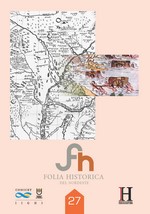Santos reyes. Virtuosos Incas. Antiguos tiranos: imagen de la monarquía en la homilética sagrada rioplatense (SS. XVIII-XIX)
DOI:
https://doi.org/10.30972/fhn.0271222Palabras clave:
Homilética, monarquía, representación, imaginarioResumen
La homilética fue un instrumento de defensa del orden político establecido o de crítica al régimen en decadencia que puede caracterizarse como un discurso religioso con fuerte contenido doctrinal e ideológico que alcanzaba a un amplio auditorio. Se pronunciaba en fiestas marianas, exequias del monarca o celebraciones cívico-religiosas. Buscaba construir modelos ideales de comportamiento transmitiendo valores y representaciones desde la cosmovisión católica; pero también fueron creadores y difusores de opinión, como piezas de teología política en las que se buscaba legitimar a la Corona o al gobierno revolucionario. Se tomaban así como figuras ideales a los santos, la Virgen o a los reyes canonizados. Se analiza aquí qué imagen de la monarquía se predicaba en general y el conjunto de ideas y creencias que sobre la figura de los monarcas españoles en particular se construyeron durante los períodos tardo-virreinal y revolucionario, en los que no dejaban de incidir los avatares político-revolucionarios y los proyectos de organización institucional.Descargas
Publicado
Número
Sección
Licencia
Se deberá adjuntar una carta, en la que se declare que "el artículo titulado XXX”, es un trabajo original, que no ha sido ni total ni parcialmente publicado en ningún medio impreso o electrónico, que no ha sido remitido simultáneamente a otra publicación y que no se encuentra actualmente en proceso de evaluación en otra publicación. En el caso que sea aceptado para su publicación, transferimos los derechos de publicación a la revista Folia Histórica del Nordeste, quien asume los derechos para editar, publicar, reproducir, distribuir copias, electrónicas o multimedia e incluir el artículo en índices nacionales e internacionales o bases de datos. Por otra parte, dejamos constancia que las afirmaciones vertidas en el mismo son de exclusiva responsabilidad de las/los autoras/es". La carta deberá estar firmada por al menos uno de los autores.






